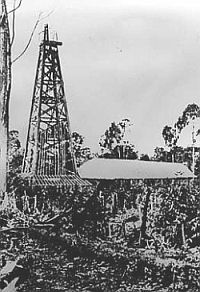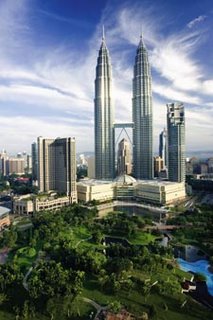
Miri – from where it all began
MIRI, declared as Malaysia’s newest city today, occupies a very special place in the history of Malaysia’s oil industry – it was here that oil was first struck in 1910.
Possibly the earliest record of the existence of oil seepages in Sarawak’s Baram-Miri District was mentioned in the diary of the Baram district officer in 1882 when he wrote of what he called “the celebrated earth oil”.
Another diary entry in 1884 suggested that “the oil district near the mouth of the Miri River should be thoroughly searched and reported on”.
In 1888, Dr Charles Hose, who became Baram district officer, took his predecessor’s suggestion to heart and began to explore these seepages himself, giving small rewards to locals who kept him closely informed of further discoveries. He soon compiled a map of the area showing no less than 28 oil seepages.
In 1907, retired but still convinced of the feasibility of commercial oil production in Miri, Dr Hose wrote to the then Rajah of Sarawak, Sir Charles Brooke, for permission to show his map and oil samples to the Shell company in London. Permission was granted and Shell was convinced enough to draw up concession negotiations with Brooke.
On terms “which were fair and satisfactory to both parties”, the areas in question were leased for 75 years from 1909 to Shell, then known as the Anglo-Saxon Petroleum Company Limited.
Shell’s chief geologist Dr Josef Theodore Erb visited Miri and carried out a geological survey of greater North Sarawak, which marked Shell’s earliest exploration for oil in Malaysia.
At this time, a number of Shell-owned and affiliated companies were also operating in British North Borneo, now Sabah. But Shell’s initial efforts met with little or no success. Shell then diverted its attention to Sarawak where Dr Erb was making considerable headway in pursuing Dr Hose’s conviction.
Reporting back to London, Dr Erb confirmed the existence of “numerous oil shows”. And in February 1910, after much investigation, the fixed the exploration site on the tip of Miri’s Canada Hill.
His selection of Canada Hill to drill instead of the swamps where the seepages were obviously occurring caused quite a stir among local Miri residents. But it was nevertheless to be indeed an event of profound significance when Malaysia’s first ever oil well was drilled and oil eventually struck on Dec 22,1910.
Called Miri Well No. 1, and now affectionately known as the Grand Old Lady, the wooden derrick erected at 79m above sea level began to produce an initial 83 barrels per day under the laborious cable tool method – a system used by the Chinese as early as 221AD to trap underground salt.
Between 1910 and 1957, 46 more onshore exploration wells were drilled in the Balingian and Baram Delta areas. By the time the last well was drilled in 1972, a total of 624 land wells had been drilled in the Miri field since the 1910 discoveries.
Malaysia’s first oil well is today a state monument and one of Miri’s tourist attractions.
After the discovery of oil in Miri, Shell built Malaysia’s first oil refinery there in 1914. The refinery was relocated to Lutong on the outskirts of Miri in 1916.
The year 1914 was also the year that Shell laid a submarine pipeline in Miri, a breakthrough in the technology of transporting crude to tankers out at sea.
Encouraged by the discovery of the Miri land field, there was no looking back for Shell as it stepped up its exploration activities and covered the entire Sarawak land mass.
The activity was extended to neighbouring Brunei, and – while the results in the rest of Sarawak proved disappointing – major discoveries were made in Seria, Brunei, in 1923.
By the late 1950s, Shell began to take the search for oil off Sarawak and Sabah. In 1960, the first mobile drilling rig ever used in Malaysia, Orient Explorer, arrived in Sarawak waters and began to explore off Baram Point.
Advances in exploration and production technology were used to meet the special challenges of ocean environments. These efforts were rewarded by the discovery of Sarawak’s first offshore field, Baram, in 1963, which coincided with the year the state became part of Malaysia.
Others followed suit – West Lutong, Tukau, Baronia, Betty, Bakau, Bokor, to name a few. The first offshore oil production began from West Lutong in 1968.
Putting its expertise to good use, Sarawak Shell pioneered the single buoy mooring system in 1960. The system, which dispenses with the need for deep-water harbour facilities, was later adapted and used throughout the world.
In 1965, Miri and its people became the first in Malaysia to enjoy all the convenience of piped gas, when Shell started a gas distribution system via the Miri Public Works Department and later through Sarawak Gas Distribution Sdn Bhd.
Petronas took over the operation of the distribution system from Shell in 1988, following which the old pipeline system was replaced and the new pipe length extended from 12km to 40km. Now, there are about 13,500 households and more than 700 commercial and industrial customers.
Meanwhile, off Sabah, oil was found at Erb West in 1971 and at Samarang in 1973. Production started in Samarang in 1975 and Sabah became Malaysia’s second oil-producing state.
More discoveries off the shores of Sabah and Sarawak followed, and the dramatic spectacle of massive oil platforms being towed out to sea became an almost common sight.
Indeed, Miri which sat on oil, grew with it or as a result of it. Oil and later the discoveries of gas fields propelled and fueled the socio-economic development of Miri and its people.













